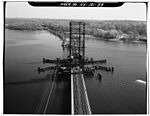Bay Plaza Shopping Center
Bay Plaza Shopping Center is a shopping center on the south side of Co-op City, Bronx, New York City. In addition to various department stores and shops, such as Macy's, JCPenney, Staples, and Old Navy, it has a multiplex movie theater, several restaurants, a fitness club, and some office space. Constructed from 1987 to 1988 by Prestige Properties, the shopping center is located between Bartow and Baychester Avenues, just outside Sections 4 and 5 of Co-op City, on an open lot that was the site of the Freedomland U.S.A. amusement park between 1960 and 1964. The Bay Plaza Shopping Center is the largest shopping center in New York City. Since opening over 25 years ago, it has become extremely successful, the center claims to hold some of the highest performing stores on a per-square-foot basis for many national retailers.
Excerpt from the Wikipedia article Bay Plaza Shopping Center (License: CC BY-SA 3.0, Authors).Bay Plaza Shopping Center
Bartow Avenue, New York The Bronx
Geographical coordinates (GPS) Address Nearby Places Show on map
Geographical coordinates (GPS)
| Latitude | Longitude |
|---|---|
| N 40.867777777778 ° | E -73.825277777778 ° |
Address
Bartow Avenue 2160
10475 New York, The Bronx
New York, United States
Open on Google Maps







